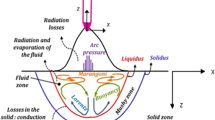Abstract
Introduction
There are several driving forces such as surface tension, buoyancy force, arc pressure, electromagnetic force, recoil pressure, drag force, etc. in gas tungsten arc (GTA) welding and laser welding, which have different influences on flow dynamics in the weld pool.
Mathematical models
This paper investigates the influence of respective driving forces on weld pool dynamics by using mathematical models and numerical simulations. In numerical simulations, the flow patterns in the weld pool and the maximum fluid velocity caused by respective driving forces can be observed, since driving forces can be applied separately.
Results and discussion
As all driving forces are applied under experimental conditions, the results of experiments and numerical simulations were compared to validate the numerical simulations and mathematical models used in this paper. In GTA welding, Marangoni flow can be considered as the most dominant force in the radial direction, while the velocity magnitudes of the z-axis direction of all respective forces except buoyancy and drag force are almost the same. The influence of buoyancy force is negligible. In keyhole laser welding, however, recoil pressure can be considered the dominant force, while the other driving forces have only a negligible influence on fluid dynamics in deep keyhole welding. In laser–GTA hybrid welding, recoil pressure can be considered the dominant force.





Similar content being viewed by others
References
Seto N, Katayama S, Matsunawa A (2000) High-speed simultaneous observation of plasma and keyhole behavior during high power CO2 laser welding: effect of shielding gas on porosity formation. J Laser Appl 12–6:245–250
Hirt CW, Nichols BD (1981) Volume of fluid method for the dynamics of free boundaries. J Comp Phys 39:201–225
Cho J-H, Na S-J (2009) Three-dimensional analysis of molten pool in GMA–laser hybrid welding. Weld J 88:35s–43s
Kim SD, Na S-J (1992) Effect of weld pool deformation on weld penetration in stationary gas tungsten arc welding. Weld J 71:179s–193s
Lee SY, Na S-J (1996) A numerical analysis of a stationary gas tungsten welding arc considering various electrode angles. Weld J 75:269s–279s
Dupont JN, Marder AR (1995) Thermal efficiency of arc welding process. Weld J 74:406s–416s
Cao Z, Yang Z, Chen XL (2004) Three-dimensional simulation of transient GMA weld pool with free surface. Weld J 83(6):169s–176s
Kou S, Sun DK (1985) Fluid flow and weld penetration in stationary arc welds. Metall Trans A 16(A):203–213
Phares DJ, Smedley GT, Flagan RC (2000) The wall shear stress produced by the normal impingement of a jet on a flat surface. J Fluid Mech 418:351–375
Sahoo P, Debroy T, McNallan MJ (1988) Surface tension of binary metal-surface active solute systems under conditions relevant to welding metallurgy. Metall Trans B 19(B):483–491
Kaplan AFH (1994) A model of deep penetration laser welding based on calculation of the keyhole profile. J Phys D: Appl Phys 27:1805–1814
Allmen M, Blatter A (1995) Laser–beam interactions with materials, 2nd edn. Springer, Berlin
Cho MH, Lim YC, Farson DF (2006) Simulation of weld pool dynamics in the stationary pulsed gas metal arc welding process and final weld shape. Weld J 85:271s–283s
Acknowledgments
Support by the Brain Korea 21 Project and Mid-career Researcher Program through NRF grant funded by the MEST (no. 2010-0027749) is gratefully acknowledged.
Author information
Authors and Affiliations
Corresponding author
Additional information
Doc. IIW-2311, recommended for publication by Commission XII “Arc Welding Processes and Production Systems.”
Rights and permissions
About this article
Cite this article
Han, SW., Cho, WI., Na, SJ. et al. Influence of driving forces on weld pool dynamics in GTA and laser welding. Weld World 57, 257–264 (2013). https://doi.org/10.1007/s40194-012-0020-4
Received:
Accepted:
Published:
Issue Date:
DOI: https://doi.org/10.1007/s40194-012-0020-4



